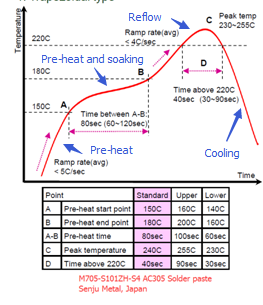

If the board is simple and there are no complex components such BGAs or big components on the board, the slumping type profile will be the better choice. The Soaking type is similar to a trapezoidal shape while the slumping type has a delta shape. Particularly, when components with different thermal. There are many others like wave soldering, baking, drying, curing, and a host of other industrial. Uneven temperature distribution poses a big challenge on reflow soldering of surface mount components. There are two different profiles involved in the reflow process – soaking type and slumping type. Most of what we profile is the reflow soldering process. The maximum allowable cooling down slope needs to be considered in order to avoid any defect from occurring. Cooling zone: In the cooling zone, the temperature is gradually decreasing and makes solid solder joints.A common peak temperature is 20–40 ☌ above liquidus. Reflow zone: The reflow zone, also referred to as the “time above liquidus” (TAL), is the part of the process where the highest temperature is reached.Soaking zone: The preheating period from 150 ° C to the alloy molten point is also known as the soaking period, which means the flux is getting active and is removing the oxidized substitute on the metal surface so it is ready to make a good solder joint between components pins and PCB pads.It also lets big components heat up consistently with other small components. The benefit of the slow warm up is to let solvent and water in the paste vapour come out on time. The temperature ramp from normal to 150° C is less than 5° C /sec (at 1.5 ° C ~ 3 ° C / sec), and the time between 150° C to 180 ° C is around 60 ~ 220 sec. Preheating zone: Preheat usually refers to increasing the temperature from normal temperature to 150° C and from 150 ☌ to 180 C.There are four steps/zones to this process - preheating, soaking, reflow and cooling.įor the traditional trapezoidal type profile base on lead free solder paste that Bittele uses for SMT assembly process: Reflow soldering is a process by which the solder paste is heated and changes to a molten state in order to connect components pins and PCB pads together permanently. Hot air reflow is used for faster profiles, especially desirous when there is a great volume of BGA rework to be accomplished.Lead-free Reflow Profile: Soaking type vs. IR reflow is preferred for micro miniature devices as the lack of air flow prevent the component from being disturbed during reflow. If the PCB is bowed or warped, they might not be able to properly fit into the final assembly or opens may be formed.īGA rework reflow sources commonly used include both hot air as well as infrared heat sources. The bowing can be exacerbated by the proximity of other components such as pin-in-hole connectors that may anchor the PCB, thereby enhancing the localized bowing under the BGA. This can be a serious problem in the case of very thin PCBs or boards with an uneven thermal mass distribution. PCB warping and bowing should be minimized by the BGA rework process. Cleaning parameters should those be used in the original assembly process. If a water-soluble paste is used, the reworked area needs to be cleaned. The solder joint between the ball and the PCB pad should be similar in size and shape to the ball/part joint. Care should also be taken to not overheat any internal thermal grease if the BGA is capped.Īfter successfully attaching the BGA to the PCB, and allowing the board to be cooled down, the perimeter row of solder joints should be visually examined. This care must be extended to components with low melting points such as connectors or standoffs or adjacent moisture-sensitive devices. In addition, care must be taken to ensure that adjacent components are not damaged during the reflow process. Ensure dwell time above reflow as per the solder paste manufacturer's specifications This application note will provide information about reflow profiles and document our recommended maximums for each phase of the reflow profile.All joints to be in the solder manufacturer's specified reflow range.Minimum joining temperature high enough to ensure good wettability.Peak joint temperature to minimize Pb dissolution.


 0 kommentar(er)
0 kommentar(er)
